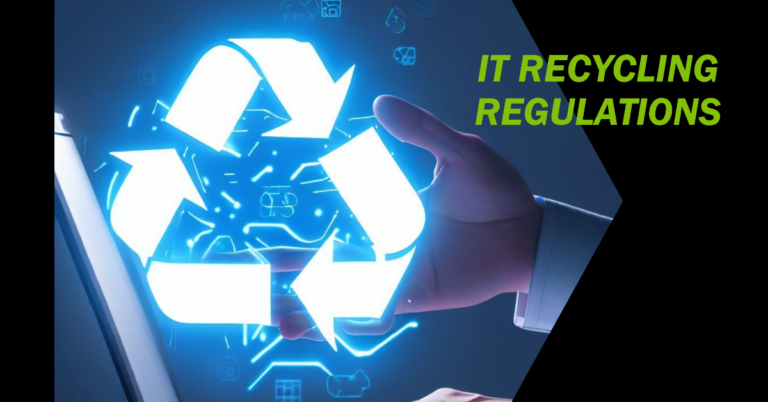Reducing E-Waste: The Necessity of Network Recycling
In our tech-driven world, the rapid pace of electronic innovations and their subsequent obsolescence have paved the way for a significant environmental conundrum: the escalating problem of electronic waste. While technological progress has streamlined our lives, it’s imperative that we understand the adverse impacts and address the pressing need for e-waste reduction. Recognizing how to reduce e waste is not just about protecting the environment but also about leveraging economic benefits and fostering sustainable tech evolution. As solutions emerge to combat this issue, one of the most promising and holistic approaches stands out: Network Recycling. Through Network Recycling, we not only find a path to manage and reduce the electronic waste generated but also set up a system that connects various stakeholders in the electronic lifecycle, ensuring that every gadget gets a second chance, either through reuse or resource recovery.
How to reduce e waste: Unveiling the E-Waste Problem
The electronics that power our modern lives, from smartphones to laptops, are double-edged swords. While they offer unprecedented convenience and connectivity, they also contribute to a looming environmental and health crisis: electronic waste. Understanding the breadth and depth of this challenge is pivotal for any meaningful e-waste reduction initiatives.
Global Scale and Staggering Statistics: The Rise of E-Waste
The scale of electronic waste production is truly global. Every year, millions of electronic devices are discarded, creating an overwhelming amount of waste. The fact that this number is continually rising underscores the urgent need for strategies on how to reduce e waste. Reports indicate that if this trend continues, e-waste will become one of the most significant waste streams, surpassing even plastics in some regions.
From Creation to Disposal: The Lifecycle of Electronics
Electronics, from the moment of their creation, are on a countdown. The raw materials mined, the energy used in manufacturing, the subsequent disposal – each stage has its environmental cost. While these gadgets have a finite lifespan in users’ hands, their impact on the environment remains long after they’re discarded. This scenario highlights the urgency to innovate and find solutions for e-waste reduction.
The Implications of Inadequate E-Waste Management
Without effective strategies to reduce and manage electronic waste, we face a plethora of environmental and health challenges. Hazardous substances like lead, mercury, and cadmium, found in many electronics, can seep into the ground, contaminating water supplies and harming ecosystems. Beyond environmental implications, the health risks for communities living near dumpsites, often in developing nations, are profound. Such realizations make the adoption of systems like Network Recycling not just beneficial but essential for a sustainable future.
How to reduce e waste: Delving into Network Recycling
In our tech-driven age, handling e-waste has evolved into a paramount concern. With the mounting pressure to find effective solutions, the concept of Network Recycling has emerged as a game-changer. Not only does it offer a viable strategy for e-waste reduction, but it also paves the way for a more sustainable technological landscape.
What is Network Recycling?
Network Recycling is an innovative approach that involves a coordinated, interconnected system of recycling facilities and processes. Instead of isolated recycling centers working independently, these facilities work cohesively, sharing resources, information, and strategies. The primary aim is to create a comprehensive network that ensures electronic waste is handled efficiently, ethically, and with the least environmental impact.
The Crucial Role of Network Recycling in E-Waste Reduction
The promise of Network Recycling goes beyond merely handling e-waste—it seeks to transform how we think about and manage discarded electronics. By enhancing collaboration and resource-sharing, this approach can significantly amplify the scale and efficiency of e-waste reduction efforts. More than just a method, it represents a holistic philosophy: emphasizing the interconnectedness of our actions and their repercussions. As a result, by adopting and promoting Network Recycling, we are better equipped to tackle the overwhelming statistics associated with electronic waste.
Understanding the Network Recycling Process
The process begins when a device reaches the end of its useful life. Instead of heading straight to a landfill, it is directed towards a facility within the Network Recycling system. Here, the device is assessed for any components that can be refurbished or reused. Subsequently, non-reusable parts are efficiently separated and processed to extract valuable materials. Through this intricate network, resources are optimally utilized, waste is minimized, and the overall environmental footprint of electronic disposal is significantly reduced. As we contemplate how to reduce e-waste, it becomes evident that such coordinated efforts are invaluable in our journey towards a more sustainable digital era.
The Broader Implications of E-Waste and Network Recycling
As we navigate the intricacies of the 21st-century technological landscape, the implications of e-waste management and the innovative solutions like Network Recycling extend beyond environmental concerns. They intersect with broader socioeconomic themes, global sustainability objectives, and policy frameworks.
Network Recycling in the Context of Sustainable Development Goals (SDGs)
The United Nations’ SDGs have set ambitious targets for 2030, aiming to address global challenges including those related to the environment, poverty, inequality, and more. E-waste, with its myriad environmental and societal implications, directly ties into these goals. Network Recycling aligns particularly with Goal 12: Responsible Consumption and Production. By creating a cohesive system for e-waste reduction, this approach promotes a circular economy, emphasizing responsible production, consumption, and waste management. Implementing and scaling up such networks is pivotal to achieving these global benchmarks.
Policy, Advocacy, and the Road Ahead for E-Waste Reduction
The importance of Network Recycling in the larger narrative of e-waste reduction cannot be understated. Governments, policymakers, and environmental advocates are increasingly recognizing the potential of such interconnected systems. However, actualizing this potential demands more than acknowledgment; it necessitates policies that incentivize sustainable e-waste management practices, stricter regulations for electronic production, and robust advocacy campaigns to educate the public about how to reduce e-waste.
The path forward is multidimensional. It encompasses international collaboration, private sector engagement, and grassroots-level initiatives—all unified under the overarching theme of e-waste reduction. Network Recycling emerges not just as a technical solution, but as a beacon for this multifaceted movement.
Success Stories in E-Waste Reduction Highlighting Network Recycling
Across the globe, there are inspiring examples of regions and organizations making remarkable strides in e-waste reduction via Network Recycling. In nations like Sweden and Japan, interconnected recycling systems have streamlined e-waste management, minimizing environmental impact and maximizing resource recovery. Private enterprises, too, are stepping up, collaborating across sectors to establish expansive recycling networks.
Such success stories underscore the efficacy and potential of Network Recycling. They serve as a testament to its scalability, adaptability, and relevance in diverse contexts. More importantly, they offer a blueprint—a vision of what is achievable when we harness the power of collaboration and innovation to tackle the pressing challenge of e-waste.
How to reduce e-waste: Conclusion
As we stand at the crossroads of technological advancement and environmental sustainability, the daunting specter of escalating e-waste looms large. Yet, in the face of this challenge, innovative solutions like Network Recycling shine a beacon of hope, illuminating the path to a more sustainable future.
Envisioning a Sustainable Future: E-Waste Reduction and the Promise of Network Recycling
The urgency of e-waste reduction is not just an environmental imperative but a societal one. Each discarded gadget, obsolete laptop, or outdated mobile phone symbolizes not only wasted resources but missed opportunities for a more circular economy. Network Recycling, with its integrated approach, emerges as a formidable response to this challenge. It reimagines the lifecycle of electronic devices, turning potential waste into reusable assets, and ensuring that we inch closer to the ideal of zero e-waste.
Furthermore, the ripple effects of adopting Network Recycling extend beyond the immediate benefits of reduced waste. It fosters job creation in the recycling sector, stimulates innovation in sustainable tech solutions, and ultimately contributes to global efforts in combating climate change.
In anchoring our hopes on solutions like Network Recycling, we’re not merely addressing the symptoms of the e-waste problem but actively redefining our relationship with technology. We’re shifting from a culture of disposability to one of responsibility. And in this paradigm shift, we find the true promise of Network Recycling—a harmonious blend of technological progress and environmental stewardship.
In essence, the call to action is clear. For the planet, for future generations, and for the continued growth and evolution of our digital age, e-waste reduction and the embrace of Network Recycling are not just commendable actions—they’re essential steps toward a sustainable and innovative future.
You can learn more about sustainable tech practices and the importance of responsible electronic disposal on our main blog.
For a deeper dive into the global impact of e-waste, refer to the World Health Organization’s insights.













